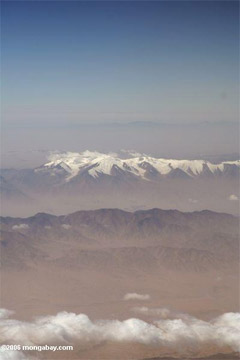Glaciers in western China shrank 20% in 40 years
Glaciers in western China shrank 20% in 40 years
mongabay.com
July 13, 2007
|
Highlights
|
Glaciers in Western China have melted at “alarming” rates over the past 40 years, according to Chinese state media.

Glaciers and snow-capped peaks in Xinjiang. Click image to enlarge. Photo by Rhett A. Butler. |
Xinhua reports that Wang Feiteng, an assistant researcher with the Tianshan Mountain glacier monitoring station under the Chinese Academy of Sciences (CAS), said the principal glacier at Tianshan has lost 20 million cubic meters of ice in the last four decades, and the east and west sections of the glacier are receding by 3.5 meters (11 feet) and 5.9 meters (19 feet), respectively every year.
The glacier is the largest in Xinjiang, China’s far northwestern province that is home to 42 percent of China’s 46,000 glaciers. China scientists report that total glacier acreage in Xinjiang has shrunk by 20 percent and snow lines have receded about 60 meters (195 feet) since 1964, while internal temperatures of glaciers have climbed by 10 percent in the last twenty years.
Chinese researchers say the changes pose a threat to water supplies in the dry parts of the country.
“Glaciers are sometimes called ‘solid reservoirs’. They are one of the major water resources in an arid region like Xinjiang,” said Hu Wenkang, a researcher with the CAS. “But melting glaciers may cause floods and landslides in some areas, and fail to provide water for rivers.”
Earlier reports have warned that the glaciers of China’s Qinghai-Tibet plateau are shrinking by 7 percent a year due to global warming. Meanwhile, on the Western side of the Himalayas, in the Upper Indus Basin, glaciers are believed to be expanding.
| Glaciers and snow-capped peaks in Xinjiang province. Photos by Rhett A. Butler. Click image for enlargement and captions. |

Glaciers and snow-capped peaks in Xinjiang province. Photos by Rhett A. Butler. Click image for enlargement and captions. |















